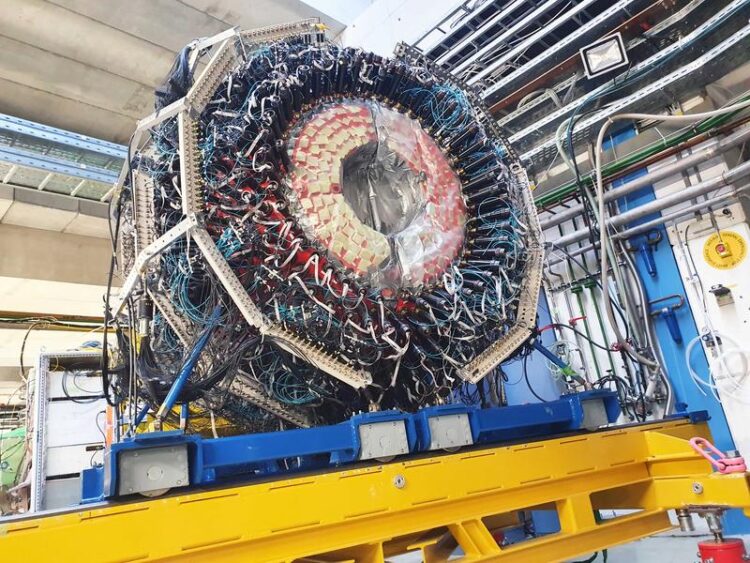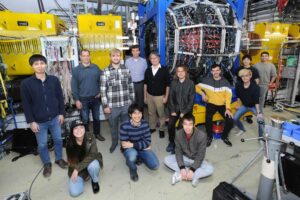On the hunt for hypernuclei

WASA's measuring instruments protrude outward like spikes. The gigantic WASA setup consists of scintillators and gaseous detectors that can detect charged and neutral particles.
Photo: G. Otto, GSI/FAIR
The WASA detector at GSI/FAIR…
With the WASA detector, a very special instrument is currently being set up at GSI/FAIR. Together with the fragment separator FRS, it will be used to produce and study so-called hypernuclei during the upcoming experiment period of FAIR Phase 0 in 2022. For this purpose, the assembly, which weighs several tons, is being transferred to the facility in a complex installation procedure. The scientific relevance of the planned experiments with hypernuclei is also shown by a recent review article in the scientific journal “Nature Reviews Physics”, in which GSI/FAIR researchers play a leading role.
Very special exotic nuclei are in the focus of researchers in the upcoming experiment period: so-called hypernuclei. Regular atomic nuclei are made of protons and neutrons, which in turn are composed of a total of three up and down quarks. If one of these quarks is replaced by another type, a so-called strange quark, a hyperon is formed. Atomic nuclei that contain one or more hyperons are called hypernuclei. They can be produced in particle collisions at accelerators, and their decay can then be observed in experiment setups such as the WASA detector and the FRS in order to study their properties in detail.

Photo: G. Otto, GSI/FAIR
Professor Takehiko Saito, leading scientist in the GSI/FAIR research pillar NUSTAR, is the first author of the paper “New directions in hypernuclear physics” in the journal Nature Reviews Physics, which highlights previous results, open questions and new possibilities in the field of hypernuclear research. “Hypernuclei could shed light on what happens inside neutron stars. According to current predictions, hypernuclei should exist there abundantly. However, some of their properties have not yet been accurately determined. Among other things, the researchers want to determine the binding energy and lifetimes of different hypernuclei more precisely in future experiments, as well as discover new variations,” Saito says. “For this purpose, the HypHI experiment, previously operated at GSI/FAIR, has already achieved exciting results, but has now reached its limits. The combination of WASA and FRS promises new insights and information. The detector has a higher detection efficiency for measuring all the decay products of the hypernuclei. In the future, the FAIR facility, which is currently being built, will also open up extensive new opportunities for the study of hypernuclei.”
WASA stands for “Wide Angle Shower Apparatus” and is designed to trace the tracks of large numbers of particles that are emitted in energetic nuclear collisions. Thus, the device is a huge, almost closed sphere, equipped with countless measuring instruments, some of which protrude outward like spikes. They consist of scintillators and gaseous detectors that can detect charged and neutral particles. Inside is a superconducting solenoid magnet that must be cooled to four Kelvin with liquid helium. Most of the detectors are currently improved by the international WASA@FRS collaboration. The Japanese team of the collaboration plays a leading role in the development and upgrade of the detector.
Responsible for the technical setup of the WASA detector at FRS are the two NUSTAR engineers Tobias Weber and Philipp Schwarz. “Due to the tight spatial constraints at the FRS, the compact and powerful WASA detector was the best choice for the planned experiments at FRS,” Weber explains. “We had to remove several parts of the FRS to make space available for WASA.” Schwarz adds: “To transport the detector to its final destination, we had to carefully move the delicate components, which weigh several tons, across our experiment halls via several overhead cranes. Fortunately, everything went well and according to schedule so far. Soon we will be able to start the commissioning at the FRS to ensure everything will be ready for the experiments next year.”
Prior to the installation at GSI/FAIR, WASA had already completed a number of experiment campaigns. The setup was originally used at the Svedberg laboratory in Sweden and later at the COSY ring at Forschungszentrum Jülich. Its installation at FRS is also only temporary. Following the upcoming experiments, it will be removed and the FRS will again be ready for other NUSTAR experiments studying further exotic nuclei.
Originalpublikation:
https://doi.org/10.1038/s42254-021-00371-w
Weitere Informationen:
https://www.gsi.de/en/start/news/details/2021/10/21/hyperkerne-wasa
Media Contact
All latest news from the category: Physics and Astronomy
This area deals with the fundamental laws and building blocks of nature and how they interact, the properties and the behavior of matter, and research into space and time and their structures.
innovations-report provides in-depth reports and articles on subjects such as astrophysics, laser technologies, nuclear, quantum, particle and solid-state physics, nanotechnologies, planetary research and findings (Mars, Venus) and developments related to the Hubble Telescope.
Newest articles

Melting Ice, Shifting Ecosystems: The Pressure Ridge Decline Explained
Analysis of three decades of aerial survey data reveals major changes In the Arctic, the old, multiyear ice is increasingly melting, dramatically reducing the frequency and size of pressure ridges….

Redefining Cancer Science: Rodents, Humans, and the PD-1 Puzzle
Results of a comprehensive analysis refute assumptions that a key immune checkpoint receptor functions the same in rodents and humans The Discovery of PD-1: A Milestone in Cancer Treatment Since…

Heart Surgery Risks: Low BP Linked to Postoperative Kidney Injury
First large cohort study at the Heart and Diabetes Center NRW awarded – Hilke Jung presents research project at the FoRUM conference of the Ruhr University Bochum A working group…



